On-farm demonstration day highlights why premium tyres are worth the investment
21st November 2024
A practical on-farm demonstration day was used by Alliance to highlight advantages of the company’s latest agricultural tyres. David Williams reports.
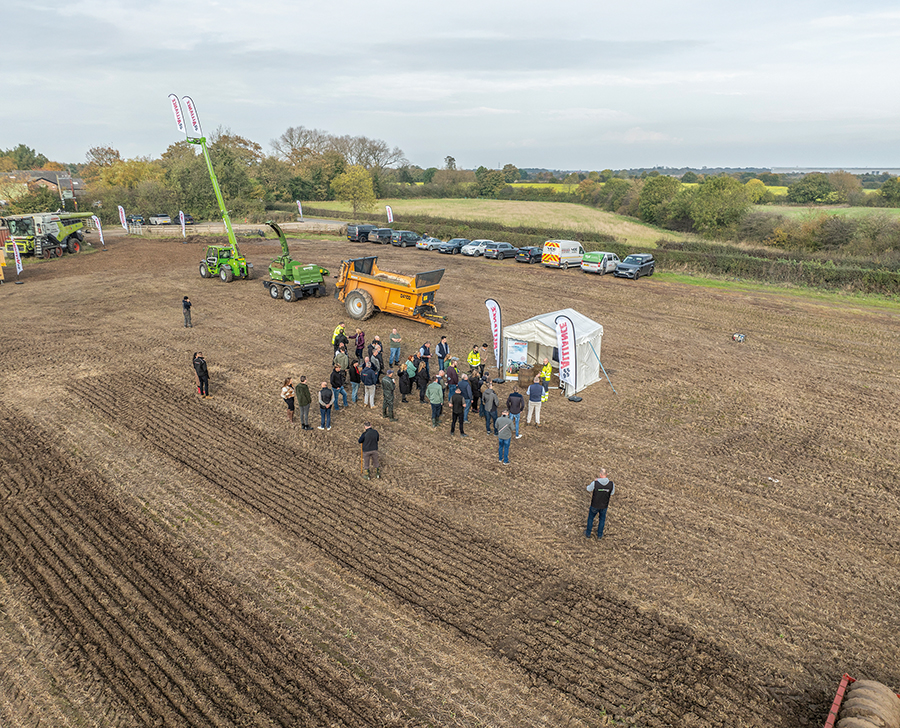
The event took place in late October at Prescott, Lancs and as well as being attended by agricultural press, there were also farmers and contractors from the local area.
The main tyres featured were the Alliance premium Agri Star 2 plus the Agriflex VF series – in 363 XT row crop and 372+ tractor and combine harvester sizes and tread patterns.
Ideal conditions
“We were lucky with the weather, and field conditions to highlight the topics we were keen to promote,” explained Alliance field service manager – Europe, Gerrit Vinkers. “Approximately 60 participants included members of the press as well as dealers and end users, and feedback was extremely positive in terms of it being a useful and informative day.”
Agri Star 2
Agri Star 2 tyres are a brand-new radial with what Alliance describes as Stratified Layer Technology which creates an evolving footprint to achieve extended traction. It also features a D (65kph) speed rating and comes with a seven-year warranty.
Stratified Layer Technology utilises a combination of multi-angle lugs, which in simple terms consists of two layers with different angles. After 40% of the new tread has worn away, then the bottom layer engages the soil instead – achieving traction levels as good as when the tyre was new. This means that superior on-field performance is maintained even after many years of use.
Advantages of the SLT claimed by Alliance include:
- Improved anti-skidding as the two layers with different profiles increase the contact area
- Excellent self-cleaning as dual step tie-bars prevent lug shuffling and act as mud breakers
- Enhanced road performance as the central lugs overlap for continuous contact
- Longer lifespan as the tread is protected by a special stubble guard and wear-resistant compound
- Excellent stability as the casing has a robust, polyester construction
- Crop protection due to the lug nose angle design and smooth profile which reduces crop damage.
- The tyres are available in 65-, 70-, 85 and 90–95-series.
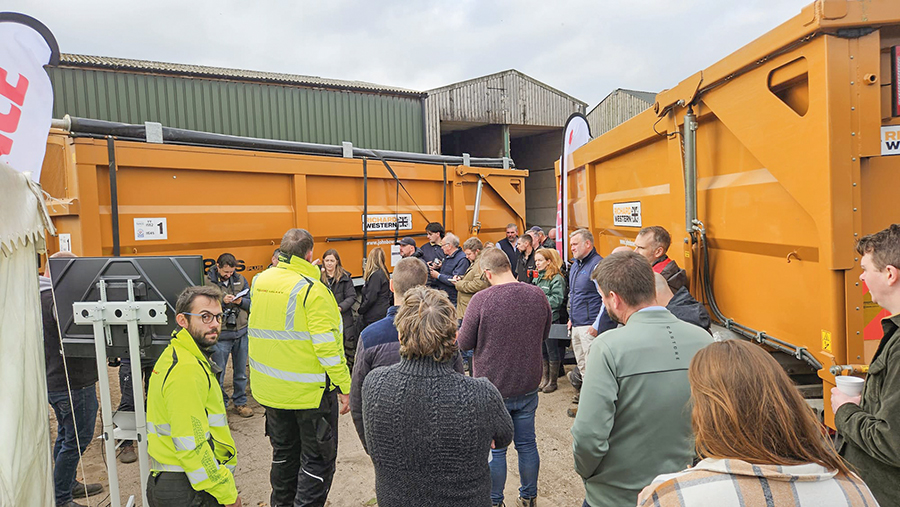
Steel belted VF radial
The Agriflex+ 372, primarily for tractors and harvesters, is the only steel-belted VF radial tyre for tractors currently on the market. It has a D-speed rating for travel up to 65kph.
Alliance stressed that protecting soils must be regarded as a priority as tractors and other farm machines become bigger and heavier.
The Agriflex VF tyres carry 40% more load than a standard radial at the same inflation pressures while achieving a much larger footprint to reduce soil compaction. The design maximises traction which brings benefits including increased productivity through faster working speeds.
Designed also for Cyclic Field Operations, (CFO) the tyres are highly rated for harvesters – including up to 35% more load carrying capability if speeds are kept below 15kph, and 13.5% extra load at up to 30kph.
Stubble protection (protecting tyres from stubble damage) is an increasingly important characteristic for combines and larger tractors used for stubble cultivations and crop protection applications, so Alliance has included its Stubble Guard compound in the manufacture. For added protection, the steel belt construction offers improved cut, chip and puncture resistance.
The tread features excellent self-cleaning through optimal lug spacing and profile.
Footprint test
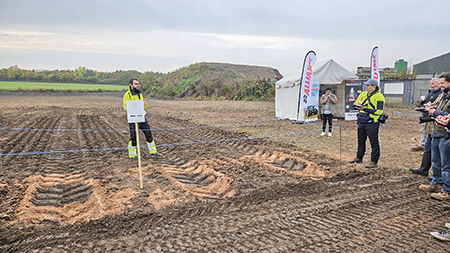
This commenced with an explanation of radial tyre construction, and the relevance of footprint size in terms of its role in soil compaction, soil pressure, traction and slip.
It was also explained how a larger footprint and ground contact area saves money in terms of fuel use, time savings and improved crop yields.
The example provided using a Fendt 728 showed how reduced inflation pressures through using the Agriflex 372 VF tyres increase the footprint length by 40%, compared to the standard radial.
Soil compaction test
This test demonstrated soil compaction, and started with an explanation of how the footprint size is a major factor.
The main message was that VF tyres can help prevent compaction, and how the longer ground contact area affects the pressure, and compaction’s role in affecting crop yields and permeability of water.
To demonstrate this, a large hole was dug in the field, and then refilled with alternating horizontal layers of soil and sand. A Fendt tractor with standard radial tyres, then another similar tractor with Alliance Agriflex 372 VF tyres travelled across the prepared test area, creating parallel wheelings. Then a trench was dug perpendicular to the travel direction so that the alternating layers of sand and soil could be observed.
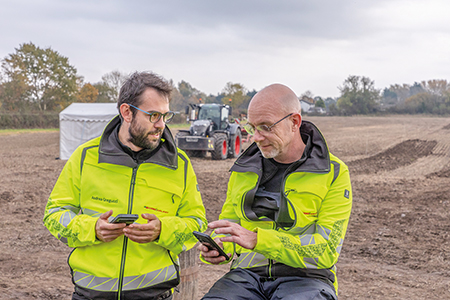
At surface level, the wheelings from the standard radials were narrower, much deeper and more pronounced, and below ground level it was clear to see that the previously horizontal layers were compressed and deformed down to at least 45cm.
The VF tyres had distributed the weight across a much longer and wider footprint, reducing ground pressure. The wheelings were wider and shallower, and below the surface the layers were distorted across a much wider area, but to a much lesser extent and depth than those below the standard tyres. Below 25cm depth, the disturbance (and compaction) was negligible.
The test demonstrated convincingly that investing in VF tyres and operating them at correct pressures can help protect soils from damage and compaction.
“This demonstration provoked the biggest response from those attending the day, and end-users said that they were surprised to see the difference in soil compaction between the two tyre types at depth,” commented Gerrit.
“In practical terms, the compaction down at 20–25cm would be easily removed by conventional ploughing, whereas removing compaction created by the standard radial at 40–45cm depth would require a subsoiler, necessitating an extra field operation with the associated costs in terms of time, fuel plus wear and tear. Reducing carbon emissions is increasingly a priority on many farms, and by reducing the need for deep cultivations, VF tyres contribute to reducing these too.”
Tyre pressure test
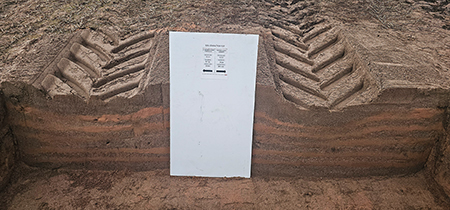
Being able to correctly identify and set suitable tyre inflation pressures is essential to get best possible performance from the tyres as well as to maximise working.
For this example, the presentation commenced with a description of the tyre as a ‘tool’ requiring an explanation of how it functions and how it should be used. Users need to understand how to read tyre data sheets, and ensure correct pressures are chosen and set to maximise tyre life, work rates and reduce fuel consumption.
For the test, the tractor with a rear mounted load was weighed, and labels giving the front and rear axle weights were attached.
Attendees then measured the pre-set pressure and compared them to those recommended on the tyre charts. The pressures were then ‘corrected’ in accordance with the charts, and settings were verified by other attendees.
Slip test – dry weather
For this practical demonstration, an explanation of grip and its effect on energy requirement, fuel use and pulling force highlighted why achieving maximum traction is important.
To ensure best performance, knowledge of how to correctly set up the tyres to improve grip and reduce slippage is required.
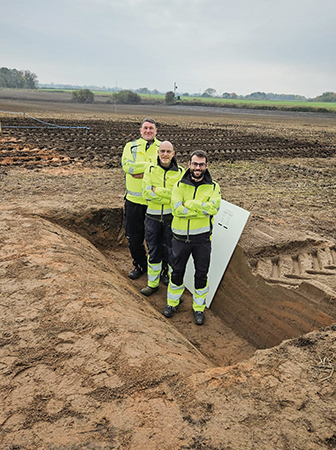
The pulling performance of the Fendt 728 with VF tyres set at high and then low inflation pressures was compared.
The simple test is easily carried out on the farm.
First, two stick markers are pushed into the ground, separated by a distance equivalent to the circumference of the tyre. The tractor, pulling a load, is driven past the first stick marker at which point a mark is made on the tyre.
As the tyre passes the second stick marker, a second mark is made at that point on the tyre. The distance between the two marks on the tyre indicates the amount of slip that occurred.
Carried out twice, once with high inflation pressures and again with lower pressures, the test illustrates the effect of inflation pressures on the footprint, grip available and traction.
In the most basic terms, carrying out the test towing a heavy trailer in soft, loose soil with the tractor tyres set at lower pressure to maximise the footprint size and achieve optimum grip can be the difference between successfully completing the journey and the combination getting stuck.
Read more machinery news
